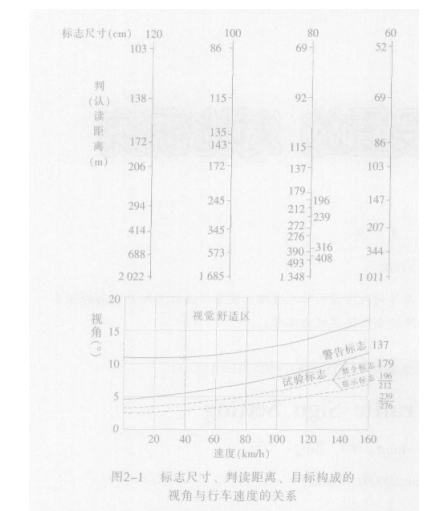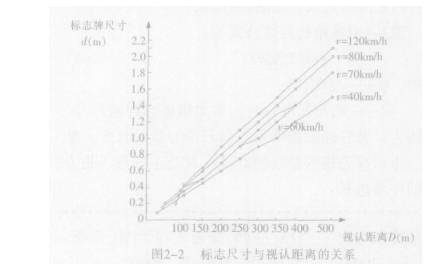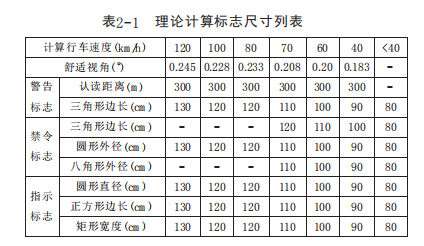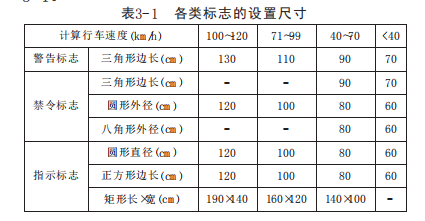Dimensional design and setting requirements for road traffic signs
Traffic Signs settings for traffic safety Has a big impact. At present, China's setting of traffic signs is detailed in the "Road Traffic Signs and Markings" (GB 5768-1999), but in practice, there are still some problems in the use of traffic signs, such as the signboard setting is too small. The setting distance is unreasonable and obstructed by other objects, so that the driver can not identify the traffic signs well. These problems often cause traffic inconvenience and even lead to traffic accidents. This paper will analyze the setting of traffic signs from both theoretical and practical aspects by comparing the settings of American traffic signs, and give relevant opinions and suggestions based on the analysis results.
2 Theoretically analyzing the size of the logo
The size of the logo is related to the calculation of driving speed, viewing distance and viewing angle. Through long-term research and experimentation, countries around the world have drawn the relationship between them, as shown in Figure 2-1.

The calculation formula of the angle of view in Figure 2-1 is:
Q=57.3d/D ( 2- 1)
where: Q viewing angle (°) ;
d Graph size (m), this article refers to the size of the traffic sign,
specifically: the warning sign refers to the length of the triangle centerline; The indicator mark refers to the diameter of the circle or the length of a square or a rectangle;
D the distance from the observer to the mark, here refers to the recognition of the mark
reading distance (m).
According to Figure 2, 1, the minimum required sign size can be calculated from the comfortable viewing angle Q at a certain speed and the reading distance D at this speed, ie:
< p="">d=QD/57.3 ( 2- 2)From the formula (2-2), the relationship between the size of the sign and the viewing distance can be obtained, as shown in the graph 2-3.

According to the formula (2- 2) and Figure 2-2, it is possible to calculate the distance between the reading distance and the traffic sign size in the comfortable viewing angle at different speeds
Department, see Table 2-1.

3 Current traffic signs in China
3.1 Classification of traffic signs
According to China's national standard "Road Traffic Signs and Markings" ( GB 5768-1999), road traffic signs are divided into two categories: main signs and auxiliary signs.
3.1.1 Main Signs
The main signs are further divided into warning signs, ban signs, signs, road signs, tourist area signs and road construction safety signs,
The details are as follows:
a) Warning Sign: Warning signs for vehicles and pedestrians to pay attention to dangerous places;
b) Ban sign: A sign prohibiting or restricting traffic behavior of vehicles and pedestrians ;
c) Indicia: A sign indicating the direction of travel of a vehicle or pedestrian;
d) Directional sign: A sign indicating the direction, location, and distance of the road;
< p="">e) Tourist area mark: A sign indicating the direction and distance of the tourist attraction;f) Road construction safety sign: A sign indicating the passage of the road construction area.
3.1.2 Auxiliary mark
Auxiliary mark means a mark that is provided under the main mark and serves as an auxiliary explanation.
3.2 Setting size of traffic signs
According to the provisions of Road Traffic Signs and Markings (GB 5768-1999), the size of the signs is determined by the road speed, see table 3- 1.

3.3 Setting position of the mark
3.3.1 Warning sign
The distance from the warning sign to the dangerous place is determined according to the calculated driving speed of the road, such as Table 3-1 shows.

3.3.2 Ban sign
The ban mark is set on a section or intersection that requires prohibiting or restricting traffic behavior of vehicles and pedestrians. Near the mouth.
3.3.3 Indicators
The indicator is located near the road or intersection where the vehicle or pedestrian is required to travel.
4 US traffic signs settings
4.1 Classification of traffic signs
According to The 2003 edition of the US logo manual "Manual on Uniform Traffic Control Devices- for Streets and Highways"
- 2003 EDITION, the traffic signs are divided into Regulatory, Warning, and Indicators (Guide) ),
is as follows:
a) Regulatory Marks: Inform drivers to pay attention to and comply with traffic laws and regulations;
b) Warning Signs: Yes Signs of reminders and warnings for dangerous locations that are not easily found;
c) Signs: directions, destinations, directions, distances, service facilities, key points and other geographic locations, recreation, cultural information Wait, bring convenience signs for people to travel.
4.2 Setting size of traffic signs
4.2.1 Regulatory signs
There are many classifications of US regulatory marks, and now they are related to the traffic signs of China. The summary of the setting dimensions is shown in Table 4-1.

3.3 Setting position of the mark
3.3.1 Warning sign
The distance from the warning sign to the dangerous place is determined according to the calculated driving speed of the road, such as Table 3-1 shows.

4.2.2 Warning Signs
The setting dimensions of the warning signs are shown in Table 4-2.
4.2.3 Indicators
The size of the traffic signs should be based on the content of the signs, and the size and spacing of the characters in the cards should be legible.
4.3 Location of Marks
4.3.1 Regulatory Marks
Regulatory Marks should be located near the location where such signs are required to be used by the driver Play the role of restraint, reminder, and warning.
4.3.2 Warning Signs
The pre-distance of warning signs is divided into condition A and condition B, both of which require the driver to react adequately and take measures. Time, to reach the warning location safely.


